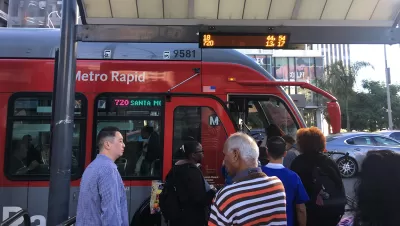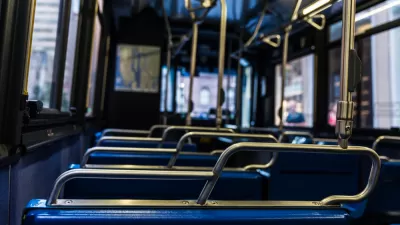A new report by the Bus Turnaround Coalition has a prescription to "build back better": fix the bus.

The Bus Turnaround Coalition this week published a plan to leverage bus public transit as a key tool in a post-pandemic economic recovery in New York.
Mark Hallum shares details of the report in an article for AM New York: "Dubbed the Big Bus Comeback, the Bus Turnaround Coalition wants the MTA to launch all-door boarding with OMNY fare collection, implementing the Bronx bus network redesign, finish planning for the Queens network, procure bus-mounted cameras for lane enforcement and revise schedules to compensate for buses running faster."
According to Hallum, one big component of a comeback for bus transit in New York would be more dedicated bus infrastructure. Mayor Bill de Blasio launched a campaign to quickly install 20 miles of new bus lanes and busways in June 2020, just a few months into the COVID-19 pandemic, but has walked back much of that commitment due to opposition from councilmembers and local businesses.
Gersh Kuntzman picked up the news of the new report in an article for Streetbslog NYC, framing the report as evidence of how easy it could be to fix bus service. "This doesn't have to be so hard," writes Kuntzman. Kuntzman also notes that the MTA already has several of the plans included in the report in motion, and it also has a large cash infusion made possible by the $1.9 trillion "American Rescue Plan" bill recently approved by Congress an signed into law by President Joe Biden.
The Bus Turnaround Coalition is a collaboration between TransitCenter, the NYPIRG Straphangars Campaign, the Tri-State Transportation Campaign, and the Riders Alliance.
FULL STORY: Transit advocates tell MTA to get rolling on bus service improvements ahead of COVID-19 recovery

Planetizen Federal Action Tracker
A weekly monitor of how Trump’s orders and actions are impacting planners and planning in America.

Congressman Proposes Bill to Rename DC Metro “Trump Train”
The Make Autorail Great Again Act would withhold federal funding to the system until the Washington Metropolitan Area Transit Authority (WMATA), rebrands as the Washington Metropolitan Authority for Greater Access (WMAGA).

The Simple Legislative Tool Transforming Vacant Downtowns
In California, Michigan and Georgia, an easy win is bringing dollars — and delight — back to city centers.

The States Losing Rural Delivery Rooms at an Alarming Pace
In some states, as few as 9% of rural hospitals still deliver babies. As a result, rising pre-term births, no adequate pre-term care and harrowing close calls are a growing reality.

The Small South Asian Republic Going all in on EVs
Thanks to one simple policy change less than five years ago, 65% of new cars in this Himalayan country are now electric.

DC Backpedals on Bike Lane Protection, Swaps Barriers for Paint
Citing aesthetic concerns, the city is removing the concrete barriers and flexposts that once separated Arizona Avenue cyclists from motor vehicles.
Urban Design for Planners 1: Software Tools
This six-course series explores essential urban design concepts using open source software and equips planners with the tools they need to participate fully in the urban design process.
Planning for Universal Design
Learn the tools for implementing Universal Design in planning regulations.
Smith Gee Studio
City of Charlotte
City of Camden Redevelopment Agency
City of Astoria
Transportation Research & Education Center (TREC) at Portland State University
US High Speed Rail Association
City of Camden Redevelopment Agency
Municipality of Princeton (NJ)





























